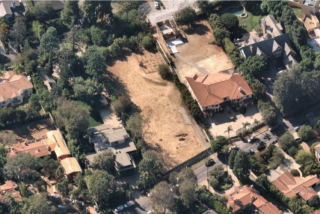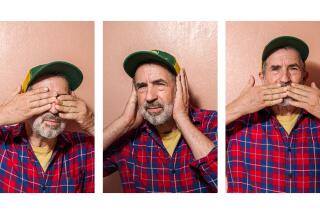Richard Pough, 99; Conservancy Chief, Bird-Guide Writer
Richard H. Pough, an unassuming man whose commitment to protecting wildlife and its natural homes led him to become the founding president of what is today the nation’s largest nonprofit environmental group, died Tuesday at his home in Chilmark, Mass. He was 99 and had brain cancer.
A mechanical engineer by training and an ornithologist by avocation, Pough became the first president of the Nature Conservancy in 1950, after a decade of work for the National Audubon Society.
Over a seven-decade career, he led battles that ranged from opposing the commercial use of wild birds’ feathers to sounding early alarms about the dangers of the insecticide DDT.
He also wrote a classic series of bird guides for the National Audubon Society that sold more than 1 million copies, and he played a key role in creating the world’s first refuge for birds of prey, Hawk Mountain Sanctuary in eastern Pennsylvania, west of Allentown.
“He was one of our icons ... a pioneer in any number of fronts in conservation, from bird protection to land protection,” said Audubon’s science director, Frank Gill, who knew Pough for 50 years. “But he was always behind the scenes ... not the big public hero.”
Pough grew up in Brooklyn and St. Louis. His father was a chemist and amateur mineralogist, and his mother was a Bostonian with a degree in biology from the Massachusetts Institute of Technology.
His interest in birds bloomed one summer during his adolescence when a polio epidemic in New York City forced his family to take an extended vacation on Block Island, off the Rhode Island coast. During the subsequent autumn he noticed that the bushes along a road he walked every day were alive with many kinds of birds in migration. He began to pore over a pocket bird guide to determine what species he had seen.
When he was 15, his father bought a Studebaker, which Pough drove across the country twice. “I fell in love with the whole country,” he said of the family trips, which turned into scientific expeditions to collect rocks and keep bird and botany lists. One of his brothers, Frederick, would later write Peterson’s Guide to Rocks and Minerals, a classic still in print after 50 years.
In addition to Frederick, Pough is survived by a son, Tristram, of Larchmont, N.Y.; another brother, Harold; and two grandchildren. He was preceded in death by his wife, Moira Flannery Pough; a son, Edward; and a granddaughter.
Pough was attending Washington University in St. Louis when he made his first foray into conservation. A representative of the local Catholic church told him of an old cemetery that the church wanted to donate as a bird sanctuary. Pough accepted the land as president of the St. Louis bird club. Soon he was engaged in other projects, including saving an old Indian burial ground in St. Louis and the last unspoiled miles of New Jersey coastline.
He went on to MIT, graduating in 1926, and Harvard, where he studied fine arts. He worked as an engineer for a few years, but never lost his passion for birds.
In 1931, he was a retail executive in Pennsylvania when he read an article that said the state was paying $5 a head for goshawks, which were considered pests because they preyed on chickens and other small game birds. He feared that the bounties would lead to indiscriminate shooting of birds of prey.
“In those days, some animals were considered good and some were considered bad,” he told the Associated Press in 1984. People thought “the only good hawk was a dead hawk.”
One Sunday afternoon he drove from his home near Philadelphia to Reading, Pa., where he asked farmers if they knew of any good places to shoot hawks. He was directed to Hawk Mountain, in the Appalachians, where he encountered a group of 25 or 30 men who were blasting birds out of the sky with rifles. Pough was outraged by the slaughter.
The next week he returned with two fellow bird watchers. The hunters were gone, but Pough found scores of dead and dying hawks they had left behind.
After putting the wounded ones out of their misery, he placed 230 dead hawks into piles and photographed them.
When the pictures were published in Bird Lore, a magazine of the National Audubon Society, they caused an uproar. Activist and bird watcher Rosalie Barrow Edge saw the photos, contacted Pough and enlisted him to help banish hunters from Hawk Mountain.
Pough arranged for the Audubon Society to buy the land. But Edge, a fierce advocate who became known as “the Joan of Arc of conservation,” distrusted Audubon. In 1934 she leased 1,398 acres of Hawk Mountain for $500; the next year, she raised the funds to buy the land and opened it to the public as a sanctuary. It now attracts tens of thousands of visitors a year, including more than 20,000 hawks, eagles and falcons.
Although Edge receives most of the credit, Pough’s role was crucial in changing the public image of birds of prey, in particular hawks.
“Richard Pough stood with the absolute defenders of hawks. He once told me he thought they were magnificent creatures,” said Nancy J. Keeler, a spokeswoman for Hawk Mountain Sanctuary.
In 1938, Pough joined the staff of the Audubon Society, where his charge was to keep a watchful eye on hawks and other “persecuted species.” His responsibilities as a sort of roving warden took him down some unexpected paths.
One day in 1939 his wife came home wearing a new feathered hat. According to Audubon historian Frank Graham Jr., Pough immediately recognized the feather as belonging to an endangered golden eagle. That day “Pough became a feather detective,” Graham wrote in his 1990 book, “The Audubon Ark.”
Pough discovered that feathered hats, popular at the turn of the century, were making a comeback because of a legal loophole that allowed the importation of wild birds’ feathers for the fishing-fly trade. The fishing-fly overstock was being snapped up by milliners. Pough found that about 40 species of exotic birds, including the rare Orillard pheasant and the roseate spoonbill, were being exploited for fashion.
He described the forces behind the trend in “Massacred for Millinery,” an article published by Audubon in 1940. The society further spread the alarms through news coverage of Pough’s inspection visits to milliners’ shops with a conservation officer in tow.
By the end of 1940, Graham noted, “luminaries such as Eleanor Roosevelt and movie star Mary Pickford announced their support for the Audubon cause.”
Soon the feather industry yielded to the pressure, agreeing to support federal and state legislation to ban future sales of wild bird plumage.
Pough later turned his attention back to his boyhood hobby of identifying birds. In 1946, Audubon published the first of three guides to the birds of North America that were written by Pough and illustrated by noted bird portraitist Don Eckelberry.
Pough’s guides advanced the genre with details about nesting and feeding habits. His writing was both colorful and concise, whether in describing the distinctive sound of a stilt sandpiper (a “low, hoarse whu or ... longer whrru ending with a sort of chatter”) or the long-billed shoveler (“The male occasionally makes a deep, guttural croaking sound, the female a weak quack”).
In 1945, Audubon President John Hopkinson Baker asked Pough to observe some experiments on the effects of DDT on birds. The chemical was being used by the U.S. military to protect troops during World War II against insect-borne diseases such as malaria. What Pough learned was that it devastated bird populations when it was used at the recommended dosage of 5 pounds per acre. He began to campaign against its widespread use by agricultural and forestry groups.
His stern warning was quoted in a 1945 issue of the New Yorker. “If DDT should ever be used widely and without care,” he said, “we would have a country without freshwater fish, serpents, frogs and most of the birds we have now.”
The dangers of DDT were not widely publicized until almost two decades later, when his friend Rachel Carson wrote “Silent Spring,” the 1962 environmental classic.
In 1950 Pough took hold of a group called the Ecologists Union, renamed it the Nature Conservancy and devoted himself to preserving wild lands and their inhabitants. As conservancy president, he traveled the country at his own expense (using income from sales of his Audubon guides) to lecture at garden clubs. There he met people with money and land and, in his soft-spoken style, persuaded them to donate to the cause.
“His approach was, who could he charm out of as much land as possible?” his son Tristram said Friday.
Through his firm but nonconfrontational style, Pough “practically invented the land preservation business in this country,” Graham, quoting a prominent conservationist, wrote in his book.
The first of Pough’s many deals for the conservancy preserved 60 acres along the Mianus River Gorge in eastern New York, where the dense canopy of ancient hemlock trees gives the forest a primeval look. He also helped preserve Corkscrew Swamp in Naples, Fla.; Congeree Swamp Forest near Columbia, S.C.; and other precious resources.
These lands are among more than 15 million acres in the U.S. and 100 million acres around the world that the conservancy has protected over the last several decades.
More to Read
Sign up for Essential California
The most important California stories and recommendations in your inbox every morning.
You may occasionally receive promotional content from the Los Angeles Times.











